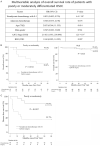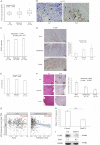Higher overall survival rates of oral squamous cell carcinoma treated with metronomic neoadjuvant chemotherapy
- PMID: 38590400
- PMCID: PMC10998753
- DOI: 10.62347/EYNT8387
Higher overall survival rates of oral squamous cell carcinoma treated with metronomic neoadjuvant chemotherapy
Abstract
Distant metastasis is an important prognostic factor for oral squamous cell carcinoma (OSCC). It involves the direct spread of tumor cells through blood vessels or via lymph nodes; however, there are currently no well-established treatments for its prevention in patients with OSCC. To investigate the impact of metronomic neoadjuvant chemotherapy on OSCC, we conducted a retrospective analysis of the efficacy of neoadjuvant chemotherapy with S-1 alone. Fifty-four patients underwent up-front surgery, while 106 received neoadjuvant chemotherapy with S-1 alone. A serious adverse event occurred in one of patient treated with neoadjuvant chemotherapy (1%); however, all patients underwent resection. The 5-year overall survival rate was higher with S-1 than with up-front surgery (96% vs. 81%, P = 0.002). Moreover, neoadjuvant chemotherapy significantly increased the overall survival rate of patients with poorly or moderately differentiated tumors, but not those with well-differentiated tumors. By analyzing a cohort of 523 head and neck squamous cell carcinoma (HNSCC) patients in the Cancer Genome Atlas, we identified genetic variants associated with histological differentiation. The frequency of pathogenic/likely pathogenic variants or deletions in 5 genes associated with HNSCC correlated with histological differentiation, some of which indicated the activation of the Wnt/β-catenin pathway in well-differentiated HNSCC. The vessel marker CD31 was highly expressed in poorly differentiated OSCC, whereas the anti-angiogenic molecule, LCN2, which is induced by the activation of the Wnt pathway, was highly expressed in well-differentiated OSCC. The present study showed that overall survival rates were higher in patients with poorly or moderately differentiated OSCC who received metronomic neoadjuvant chemotherapy, which was attributed to a difference in angiogenesis based on the characteristic landscape of pathogenic mutations according to histological differentiation.
Keywords: Metronomic neoadjuvant chemotherapy; distant metastasis; histological differentiation; oral squamous cell carcinoma.
AJCR Copyright © 2024.
Conflict of interest statement
None.
Figures








Similar articles
-
A molecular signature of well-differentiated oral squamous cell carcinoma reveals a resistance mechanism to metronomic chemotherapy and novel therapeutic candidates.J Drug Target. 2021 Dec;29(10):1118-1127. doi: 10.1080/1061186X.2021.1929256. Epub 2021 May 27. J Drug Target. 2021. PMID: 33979258
-
EphA4 signaling is involved in the phenotype of well-differentiated oral squamous cell arcinoma with decreased tumor immunity.Eur J Pharmacol. 2023 Apr 15;945:175611. doi: 10.1016/j.ejphar.2023.175611. Epub 2023 Feb 18. Eur J Pharmacol. 2023. PMID: 36804938
-
Outcomes after up-front surgery and metronomic neoadjuvant chemotherapy with S-1 or UFT for early tongue squamous cell carcinoma.Clin Oral Investig. 2019 Jun;23(6):2593-2598. doi: 10.1007/s00784-018-2689-2. Epub 2018 Oct 13. Clin Oral Investig. 2019. PMID: 30317400
-
The efficacy of neoadjuvant chemotherapy as compared to upfront surgery for the management of oral squamous cell carcinoma: a systematic review and meta-analysis.Int J Oral Maxillofac Surg. 2024 Jan;53(1):1-10. doi: 10.1016/j.ijom.2023.03.007. Epub 2023 Apr 21. Int J Oral Maxillofac Surg. 2024. PMID: 37088590
-
Neoadjuvant chemotherapy in oral cancers: Selecting the right patients.Indian J Med Paediatr Oncol. 2015 Jul-Sep;36(3):148-53. doi: 10.4103/0971-5851.166716. Indian J Med Paediatr Oncol. 2015. PMID: 26855522 Free PMC article. Review.
Cited by
-
Efficacy of oral metronomic chemotherapy in the management of head and neck squamous cell carcinoma-a systematic review.Front Oral Health. 2025 Jul 30;6:1632316. doi: 10.3389/froh.2025.1632316. eCollection 2025. Front Oral Health. 2025. PMID: 40809955 Free PMC article.
-
Mechanism of apoptosis in oral squamous cell carcinoma promoted by cardamonin through PI3K/AKT signaling pathway.Sci Rep. 2024 Sep 5;14(1):20802. doi: 10.1038/s41598-024-71817-1. Sci Rep. 2024. PMID: 39242879 Free PMC article.
-
Evaluating the link between periodontitis and oral squamous cell carcinoma through Wnt/β-catenin pathway: a critical review.Front Oral Health. 2025 May 12;6:1575721. doi: 10.3389/froh.2025.1575721. eCollection 2025. Front Oral Health. 2025. PMID: 40421179 Free PMC article. Review.
References
LinkOut - more resources
Full Text Sources
Research Materials
Miscellaneous
